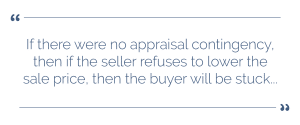What does it mean to remove an appraisal contingency and what does it entail? This article provides an in-depth understanding of the concept of Waiving an Appraisal Contingency in a real estate purchase agreement. It explains the implications of an appraisal coming back lower than the offer, and the potential consequences if there is no appraisal contingency in place. The article also offers advice on how to navigate such situations, highlighting the importance of legal representation in purchase and sale disputes.
How Do You Remove an Appraisal Contingency?
In a real estate purchase agreement, generally, there are certain contingencies that need to be met before the sale can move forward.
If those contingencies are not met and not waived, then the buyer can cancel the agreement and receive a full refund of his earnest money deposit. One of these contingencies is the appraisal contingency.
When a buyer obtains financing to purchase a home, a lender will appraise the value of the house to determine whether the loan amount is appropriate for the value of the house.
This is because the lender does not want to lend the buyer an amount of money that exceeds the value of the house or the percentage basis of equity to which the lender is willing to lend.
Appraisals Lower Than Offer
If the appraisal comes back lower than your offer, then the lender will likely reduce the loan amount to the value of the property. Unfortunately, this means that the buyer will be stuck with a purchase price that is more than the amount of a loan the lender will approve.

For example, if the buyer made an offer to purchase a house for $900,000.00, with a 20% deposit of $180,000.00 and applied for a loan for the $720,000.00 balance of the purchase price, the lender will typically approve a loan for $720,000.00 if the house appraises for at least $900,000.00.
If the house appraises for less, for example, $850,000.00, then the lender may approve a loan for only $670,000.00. If this happens, then the buyer must either ask the seller to lower the sale price, come up with the cash to cover the additional $50,000.00, or back out of the sale.
No Appraisal Contingency
If there were no appraisal contingency, then if the seller refuses to lower the sale price, then the buyer will be stuck in the position of either trying to come up with $50,000.00 cash or back out of the sale and risk losing his earnest money deposit.
Key Takeaways:
- Understanding Appraisal Contingency: In a real estate purchase agreement, an appraisal contingency is a clause that allows the buyer to cancel the agreement and receive a full refund of his earnest money deposit if the house’s appraised value is less than the loan amount.
- Implications of Lower Appraisals: If the appraisal comes back lower than the offer, the lender may reduce the loan amount to the value of the property. This could leave the buyer with a purchase price that exceeds the loan amount approved by the lender.
- Risks of No Appraisal Contingency: Without an appraisal contingency, the buyer may be forced to cover the difference in cash if the seller refuses to lower the sale price. Alternatively, the buyer may back out of the sale and risk losing his earnest money deposit.
- Legal Representation: The article emphasized the importance of legal representation in purchase and sale disputes, offering consultation services for such situations.
Our purchase and sale dispute attorneys can offer representation with your purchase and sale dispute. To schedule a consultation with one of our attorneys, please give us a call at (310) 954-1877, text us at (310) 706-2265, or send us a message here.



